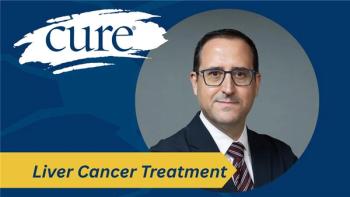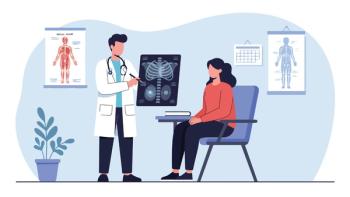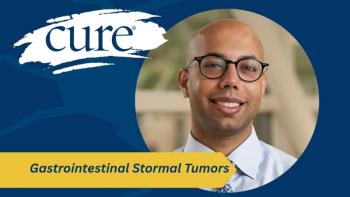
Biomarker Testing Remains Crucial for Young Patients With Lung Cancer

Key Takeaways
- Young lung cancer patients have a higher incidence of targetable biomarkers, necessitating comprehensive testing for ALK fusions and EGFR mutations.
- Repeat biomarker testing is essential when resistance to targeted therapies occurs, revealing new mutations and guiding treatment adjustments.
Biomarker testing is vital for all patients with lung cancer, especially younger individuals who have higher rates of actionable mutations.
Biomarker testing for patients with lung cancer is critical, especially for those with young onset lung cancer, according to study findings presented at an Educated Patient® Lung Cancer Summit.
Young patients with lung cancer had a 59% higher chance of having a targetable biomarker, with increased rates of ALK fusions (up to 36%) and likely EGFR exon 19 deletions. ERBB2 mutations and RET/ROS1 fusions also trended higher (up to 7% to 9%), while BRAF V600E and KRAS mutations, especially G12C, were less common.
“What this means for us is that we still need to test all patients for all biomarkers, regardless of age,” Dr. Soo-Ryum (Stewart) Yang said during his presentation. “However, in our younger patients, we really need to prioritize and ensure testing for ALK fusions, EGFR mutations and other rare but highly actionable alterations that are more likely to be present in this group.”
Yang is a board-certified pathologist and an assistant attending pathologist in Diagnostic Molecular Pathology at Memorial Sloan Kettering Cancer Center, located in New York, New York.
Testing for biomarkers guide disease diagnosis and classification, informs clinical behavior as well as the natural course of the disease and predicts clinical responses to specific therapies, according to Yang.
Why Repeat Biomarker Testing is Important
When targeted therapies stop working, it’s usually because the cancer has developed resistance. In lung cancers with EGFR, ALK or other oncogene alterations, this can happen in three ways. One is on-target resistance, where new mutations develop in the same pathway — such as EGFR C797S — that make the drug less effective. Another is off-target resistance, where different oncogenic changes emerge, like MET amplification or RET fusions.
The cancer may also undergo histologic transformation, shifting from adenocarcinoma to small cell carcinoma, which can only be confirmed with a tissue biopsy. It’s essential to perform both liquid and tissue biopsies when the cancer progresses as some of these resistance mechanisms can be treated with other targeted therapies. Repeat biomarker testing helps uncover what’s changed and gives patients the best chance at receiving effective, personalized treatment, according to Yang
Current Barriers to Biomarker Testing
Cost, turnaround time and sample quality are the top barriers to biomarker testing, according to an International Association for the Study of Lung Cancer (IASLC) survey, which also found that 43% of patients are started on treatment before even receiving their test results.
The survey reported a median 14-day turnaround time for tissue biomarker testing, though no consensus emerged on where delays occur. Nearly half of pathologists (48%) cited insufficient tissue as the most common reason testing is not performed in later-stage disease. In addition, 39% of respondents said reflex biomarker testing — where tests are automatically ordered based on initial results — is not routinely practiced.
To overcome these obstacles, the IASLC identified seven strategies: implement standardized testing protocols; advocate for policy and funding support; reduce cost and improve reimbursement; increase awareness and education; provide logistical support; expand access; and promote further research.
Three Ways to Detect Actionable Biomarkers, and Liquid Biopsies
According to Yang, there are three main types of tests that help identify biomarkers that guide cancer treatment: PCR-based, next-generation sequencing (NGS) and immunohistochemistry.
PCR-based testing looks at DNA or RNA to find specific mutations or fusions. It generally focuses on just one or a few genes, making it fast — results usually come back in two to four days — and ideal for detecting common alterations in genes like EGFR, KRAS and BRAF; however, it may miss fewer common changes.
NGS also analyzes DNA or RNA but can scan hundreds of genes at once. This broader approach can uncover mutations, fusions, amplifications, and deletions. While NGS offers a more complete picture, it takes longer — usually five to 10 days. In addition, DNA-based NGS can miss clinically actionable fusions, or can detect fusions that may not be actionable.
Immunohistochemistry (IHC) detects protein overexpression and focuses on one marker at a time. It’s commonly used for checking PD-L1 or HER2 levels and can also help flag ALK fusions. IHC uses just one slide and returns results in two to three days.
Liquid biopsy for patients with non-small cell lung cancer is a fast, non-invasive blood test for detecting actionable genetic biomarkers, especially when tissue biopsy is insufficient or not possible. This method uses NGS to examine cell-free DNA released by tumors.
It is best suited for patients with advanced (stage 4) disease, where sensitivity reaches 60% to 70%. However, its performance is lower in early-stage. Liquid biopsy is best at identifying mutations but is less reliable for detecting gene fusions or amplifications and cannot assess protein expression by IHC.
Importantly, a negative result may reflect a false negative — so tissue testing is recommended when possible. A combined tissue and liquid biopsy approach provides the most comprehensive view of a patient's tumor profile.
“It's really important that we use a whole set of different and complementary assays to ensure a guideline complete and comprehensive biomarker testing,” Yang stated in the presentation.
For more news on cancer updates, research and education,





